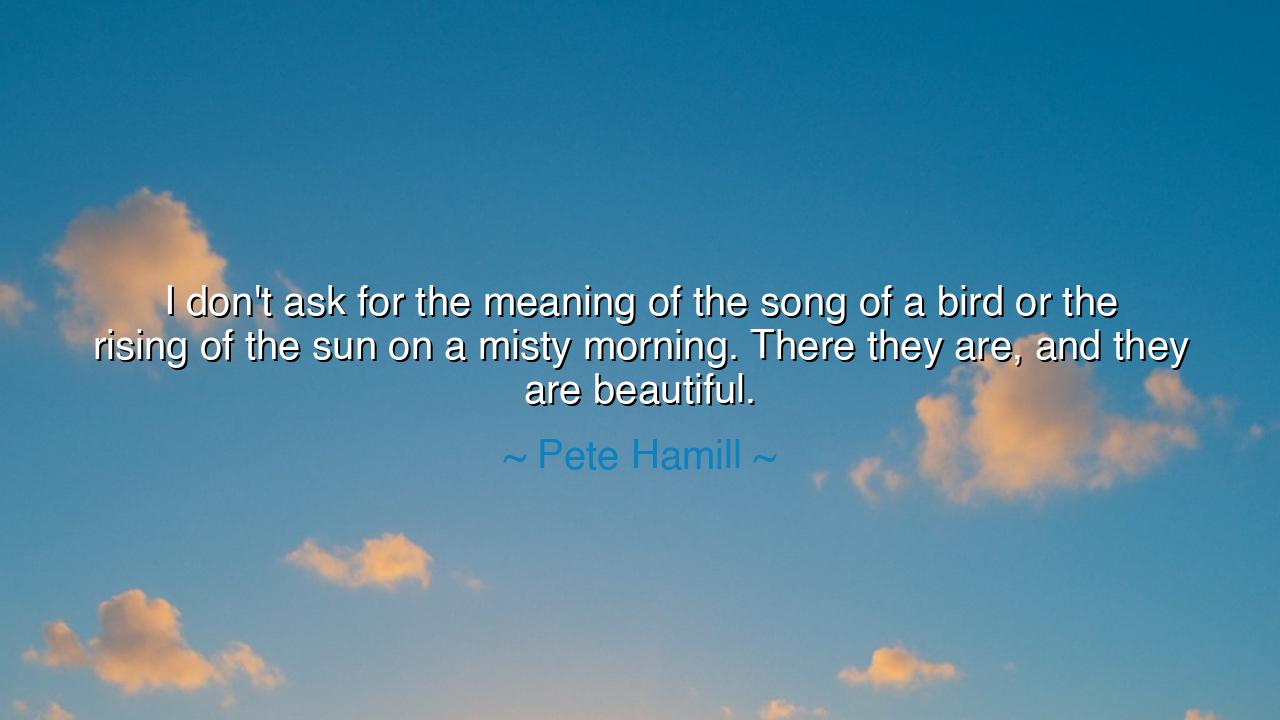
I don't ask for the meaning of the song of a bird or the rising
I don't ask for the meaning of the song of a bird or the rising of the sun on a misty morning. There they are, and they are beautiful.






When Pete Hamill declared, “I don’t ask for the meaning of the song of a bird or the rising of the sun on a misty morning. There they are, and they are beautiful,” he was reminding us of the ancient truth that not everything in life must be dissected or explained. Some things exist to be experienced, not analyzed. His words are a hymn to presence, a call to wonder, and a rejection of the endless human impulse to reduce beauty into definitions. For in trying to capture the essence of such things with reason, we risk losing the joy of simply beholding them.
The origin of this quote comes from Hamill’s life as a journalist and writer, one who was deeply familiar with the world’s hardships, politics, and suffering. Surrounded by the chaos of the human condition, he cherished those rare, unshakable truths of beauty: the bird’s song, the sun’s rising. These were reminders that life is not only a battlefield of meaning, but also a garden of mystery. In acknowledging them without question, Hamill lifted his gaze beyond the need for explanation and entered into gratitude.
History provides us with parallels. The Japanese tradition of hanami, the viewing of cherry blossoms, has never required that one ask, “What do these blossoms mean?” The petals fall, the colors bloom, and for a brief moment the world is made luminous. The beauty lies not in analysis, but in fleeting experience. Likewise, the mystic poet Rumi once wrote, “Let the beauty we love be what we do,” urging us not to trap beauty in words, but to dwell within it. Hamill’s rose-colored morning, the bird’s untamed melody, belong to this lineage of lived wonder.
His words also stand as a rebuke against the tyranny of over-explanation. In our quest to measure, dissect, and control, we often forget that beauty is not a puzzle to be solved, but a gift to be received. The rising sun does not require a philosopher’s commentary to be glorious; the bird does not need a critic to declare its song worthwhile. They simply are. And in their existence, they remind us that life itself, unasked and unearned, is a gift.
Yet, there is a deeper power here: Hamill is teaching us the practice of acceptance. To embrace beauty as it is, without demand for reason, is to cultivate humility. It is to recognize that not all things bend to human understanding, and that is well. For when we release the need to explain, we make space to feel, to rejoice, and to be transformed by what is before us. The misty morning, quiet and unassuming, becomes a teacher in silence.
The lesson for us is this: learn to see without needing to know. When you encounter beauty, resist the urge to explain it away. Let the song of the bird simply be music. Let the rising of the sun be warmth and wonder. Practice gratitude without interrogation, wonder without control. In doing so, you will discover a peace deeper than knowledge—a communion with life as it is, radiant and untamed.
So let Hamill’s words echo in your soul: “There they are, and they are beautiful.” Make this your prayer when faced with the small miracles of the world. Do not crush them beneath the weight of questions, but let them live within you as reminders of life’s grace. For the greatest wisdom is sometimes not in knowing why, but in bowing before what is—unasked, unexplained, yet wholly beautiful.






AAdministratorAdministrator
Welcome, honored guests. Please leave a comment, we will respond soon